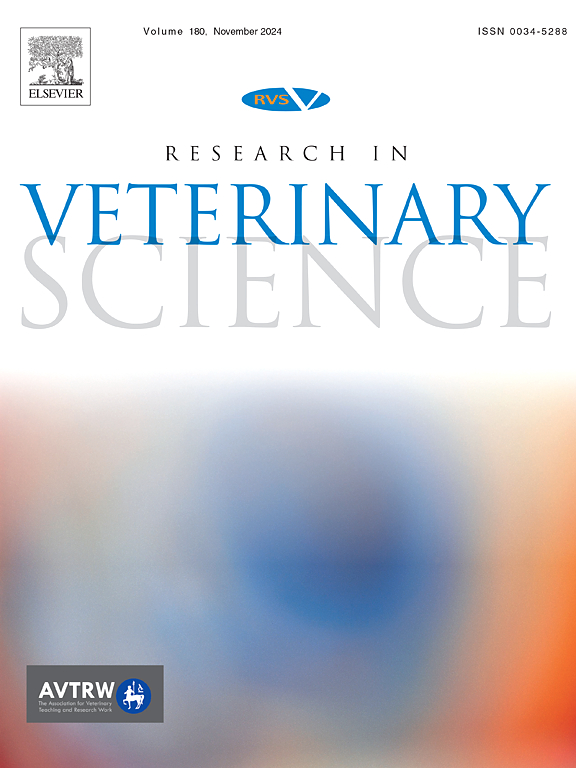巴西半干旱地区奶山羊的钩端螺旋体病血清流行率和相关风险因素。
IF 2.2
3区 农林科学
Q1 VETERINARY SCIENCES
引用次数: 0
摘要
钩端螺旋体感染是一种世界性人畜共患病,主要由于繁殖障碍给山羊饲养造成经济损失。因此,本研究旨在确定巴西东北部帕拉伊巴州和伯南布哥州山羊奶产区钩端螺旋体病的血清流行率和相关风险因素。血清学方法采用显微凝集试验,风险因素分析采用单变量和多变量分析。在采样的 937 头动物中,102 头(10.9%;95 % CI = 8.9-12.9%)的钩端螺旋体血清反应呈阳性,最常见的血清群为 Ballum(41.2%;95 % CI = 31.6-50.7 %)、Icterohaemorrhagiae(25.5 %,95 % CI = 17-33.9 %)和 Semaranga(23.5 %,95 % CI = 15.3-31.8 %),抗体滴度从 1:50 到 1:200 不等。51 个畜群中有 34 个(66.7%;95 % CI = 53.7-79.6%)至少有一只动物血清反应呈阳性。在多变量两级随机效应二元逻辑回归中确定的风险因素是动物为成年动物(几率比 = 4.2; 95 % CI = 1.93-9.13; P本文章由计算机程序翻译,如有差异,请以英文原文为准。
Leptospirosis seroprevalence and associated risk factors in dairy goats in the Brazilian semi-arid region
Leptospira spp. infection is a worldwide zoonosis that causes economic losses to goat rearing, mainly due to reproductive disorders. Hence, the objective of this research was to determine the seroprevalence and associated risk factors of leptospirosis in a goat milk-producing region in the states of Paraiba and Pernambuco, Northeast Brazil. The microscopic agglutination test was used as serological method and risk factor analysis was carried out using univariable and multivariable analyses. Out of the 937 animals sampled, 102 (10.9 %; 95 % CI = 8.9–12.9 %) were seropositive for Leptospira spp. and the most frequent serogroups were Ballum (41.2 %; 95 % CI = 31.6–50.7 %), Icterohaemorrhagiae (25.5 %, 95 % CI = 17–33.9 %) and Semaranga (23.5 %, 95 % CI = 15.3–31.8 %), with antibody titres ranging from 1:50 to 1:200. Thirty-four of 51 herds (66.7 %; 95 % CI = 53.7–79.6 %) had at least one seropositive animal. The risk factor identified in the multivariable two-level random effect binary logistic regression was the animal being an adult (odds ratio = 4.2; 95 % CI = 1.93–9.13; P < 0.001). Our results provide important information on the epidemiology and risk factors associated with goat leptospirosis seroprevalence in one of the main Brazilian goat milk-producing regions. Furthermore, the need for adopting sanitary control measures, especially those involving sanitary management practices, is highlighted.
求助全文
通过发布文献求助,成功后即可免费获取论文全文。
去求助
来源期刊

Research in veterinary science
农林科学-兽医学
CiteScore
4.40
自引率
4.20%
发文量
312
审稿时长
75 days
期刊介绍:
Research in Veterinary Science is an International multi-disciplinary journal publishing original articles, reviews and short communications of a high scientific and ethical standard in all aspects of veterinary and biomedical research.
The primary aim of the journal is to inform veterinary and biomedical scientists of significant advances in veterinary and related research through prompt publication and dissemination. Secondly, the journal aims to provide a general multi-disciplinary forum for discussion and debate of news and issues concerning veterinary science. Thirdly, to promote the dissemination of knowledge to a broader range of professions, globally.
High quality papers on all species of animals are considered, particularly those considered to be of high scientific importance and originality, and with interdisciplinary interest. The journal encourages papers providing results that have clear implications for understanding disease pathogenesis and for the development of control measures or treatments, as well as those dealing with a comparative biomedical approach, which represents a substantial improvement to animal and human health.
Studies without a robust scientific hypothesis or that are preliminary, or of weak originality, as well as negative results, are not appropriate for the journal. Furthermore, observational approaches, case studies or field reports lacking an advancement in general knowledge do not fall within the scope of the journal.
 求助内容:
求助内容: 应助结果提醒方式:
应助结果提醒方式:


